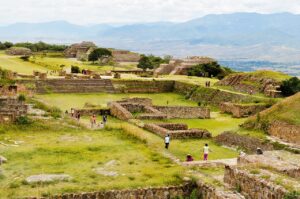An Ancient Recipe For Social Success
No Comments yetNew evidence and understandings about the structure of successful early societies across Asia, Africa, and the Western Hemisphere are sweeping away the popular assumption that early societies tended toward autocracy and despotism.
Archaeology has a more valuable story to tell: Collective action and localized economic production are a recipe for sustainability and broader well-being. The Mesoamerican city of Monte Albán, which was a major regional urban center for 1,300 years, is a shining example. It is a powerful case study that early investments in public infrastructure and goods foster longer-term sustainability.
There is a rich vein of insight here for some of the most pressing challenges faced by humanity: billions of people living in poverty, and collapsing social structures in the developing world. And in the wealthy industrialized world, many are increasingly disillusioned by the flaws in our political and economic models.
But if we’re going to use the models from the ancient past, can we be confident about how early societies really operated?
Researchers have begun to identify archaeological evidence that works as indicators for political and social behaviors and institutions:
– Is there evidence of extreme wealth disparity or equality in lifestyle or burial?
– Does monumental architecture foster exclusivity (elite tombs, aggrandizing monuments, evidence of dynastic legitimation) or access (e.g., open plazas, wide access ways, community temples)?
– Are palaces prominent or is it not clear where the leader resided?
– Does art emphasize lineal descent, divine kingship, and royal patron deities or does it feature more abstract themes such as fertility or integrative cosmological principles?
There is a lot we can determine from a society’s tendency toward the first or second option in each of these questions about whether it was more autocratic or associated with collective/good governance.
In a study of 26 early urban centers in Mesoamerica, Monte Albán was one of 12 that was characterized as a collectively organized city based on a series of indicators. Prior to the city’s abandonment, Monte Albán was not highly unequal: there were few, if any, lavish tombs, no great caches of household riches or other evidence of extreme wealth differences, and no large, ornate palace that was unequivocally the ruler’s residence.
From early in the site’s history, the city’s core was centered on a large plaza that could have accommodated a significant proportion of the site’s population. Flattening the hill’s rocky top and then defining and creating this large open space entailed planning, coordination, and cooperation. Until very late in the city’s history, material representations of rulers were relatively rare, and there is an overall lack of ruler aggrandizement. During the city’s first four centuries (500–100 BCE), there were few depictions of seemingly important individuals or leaders. Rule was largely faceless.
How did it happen?
In this light, let’s travel to the early sedentary villages (c. 1500–500 BCE) in the Valley of Oaxaca—the largest expanse of flat land in Mexico’s Southern Highlands. They were situated on or near well-watered land.
Around 500 BCE, however, a new hilltop center, Monte Albán, was established at the nexus of the valley’s three arms, where agriculture was far riskier due to unreliable rainfall and a dearth of permanent water sources. During the era of its establishment, not only was Monte Albán larger than any earlier community in the region, but many other settlers moved into the rural area around Monte Albán.
This marked shift in settlement patterns and the underlying processes associated with the foundation of Monte Albán have long been debated. How can we account for the immigration of people, some likely from beyond the region itself, to an area where they faced greater risks of crop failure?
One perspective, reliant on uniform models of premodern states as despotic, viewed the process from a basically top-down lens; leaders coerced their subjects to move near the capital to provide sustenance for the new center.
Yet more recent research has found that governance at Monte Albán was generally more collective than autocratic, and in its growth period, productive activities were collective, centered in domestic units and not managed from above.
By the time Monte Albán was established in the Valley of Oaxaca, more than a thousand years had passed since foragers transitioned from mobile lifeways to sedentary communities. Maize, beans, and squash, which had been domesticated prior to village formation, were key elements of an agricultural economy, with maize providing the bulk of calories. Early villagers also exploited a mosaic of other natural resources including clay for making ceramic vessels and figurines, stone for making tools and ornaments, and plant materials for processing into a range of woven products.
The shift to sedentary life was a long social process through which formerly dispersed populations not only adjusted but committed to living in larger communities and interacting with more people on a daily basis.
The Valley of Oaxaca has a climate that is semiarid, rainfall is unpredictable and spatially patchy across the region, and not all sectors of the valley floor receive the minimum annual precipitation necessary for reliable rainfall farming of maize, the region’s staple and culturally most important crop.
The prime factor that determines the productivity of maize is the availability of water, and a diversity of water management practices have been used since prehispanic times. These manipulations, which increase agricultural yields, include wells and pot irrigation, check dams, and small-scale canals, all of which were easily managed or implemented at the household level.
The Valley of Oaxaca was a core politico-economic region. Prior to Monte Albán’s founding, most of the populace resided in one of three clusters of settlements that were separated from the others by largely unoccupied areas, including the center of the valley where Monte Albán was later situated. In each arm, a cluster of smaller communities surrounded one larger settlement that had special functions and served as the “head towns” of small competing polities.
This millennial pattern was broken when Monte Albán was built on a steep hilltop in the center of the valley. The settlement’s establishment and rapid growth in size and monumentality set off a dynamic episode of innovation and change that included demographic, dietary, and other economic shifts. Populations grew rapidly not only at the new center, which became the largest and most monumental city in the valley’s early history, but also in the surrounding countryside. The center and rural communities were integrated through an emergent market network that provisioned the city.
This dramatic episode of change required the coordination of labor to build the new city. The rocky hilltop was flattened into a large main plaza with monumental buildings constructed along its edges. The scale and orientation of this central plaza represent a key transition from prior community plans in the region. Residences for the city’s burgeoning population were constructed on the steep slopes of the hill by creating flattened spaces, or terraces, shored up by stone and earthen retaining walls, each of which sustained a domestic unit.
The allocation of the hill’s apex for civic-ceremonial space and the lower slopes for commoner residences was a blueprint for a broad social accord. Built environments are not neutral, but political, and Monte Albán’s footprint with a large, relatively open central space and little display of hierarchical leaders points to a collective arrangement.
The city’s concentrated residential precincts comprised strings of artificially flattened terraces that shared long retaining walls. Construction of the terraces required allotments of domestic labor to clear trees, flatten steep inclinations, erect stone walls to retain flat spaces where houses would be built, and construct drainage channels to divert rainwater from living spaces. The construction, sharing, and maintenance of front retaining walls involved high degrees of interhousehold cooperation between neighbors.
Additionally, commoners adopted construction techniques and basic ceramic wares that previously were the domain of high-status families. In the early city, most houses included contiguous rooms with plaster floors, often constructed around a patio; they were built with adobe bricks on stone foundations instead of the mud and thatch typical of earlier commoner houses. The pottery wares that previously were largely used by higher-status families or as ceremonial vessels became more broadly distributed in the centuries after Monte Albán was established. This level of cooperation and coordination is evidence of a social charter or norms, in which a wider array of residents had access to what previously had been higher-status materials and goods.
No large-scale production has been uncovered, and there is no indication of central-governmental food storage at Monte Albán, as one might expect with top-down economic control or redistribution.
Economic production at Monte Albán was situated in domestic contexts. Instead of being coerced to move to Monte Albán, people were attracted to the city. Monte Albán was settled by a sizable group, possibly as large as 1,000 people, and rapidly grew to about 5,000 people within a few hundred years. Populations also increased in the rural areas around Monte Albán, and the annual rate of population growth in the valley exceeded what could have been maintained by natural increase alone. Populations expanded again in and around Monte Albán after c. 300 BCE. The threefold growth was too large to be accounted for by local, “natural growth,” so that people must have been drawn to Monte Albán and the valley from more distant, extra-regional locations.
Evidence indicates that the agricultural catchment for feeding Monte Albán likely extended 20 kilometers from the city. The market and exchange networks that moved food to the city created a high degree of interconnection among small settlements and Monte Albán. This interdependence required cooperation, infrastructure, and institutions that together provided the means of moving food and distributing seasonal surpluses.
Prior to Monte Albán, early “head towns” were generally positioned adjacent to good farmland. But the new city was located in an area of the valley where agriculture was riskier and largely dependent on unpredictable rainfall. Why would people move to a place where they faced a high risk of crop failure, where they could have been taxed more highly, and where, if governance were coercive, they had little voice? Such a scenario seems improbable, and it is far more likely that people moved to Monte Albán to take advantage of economic opportunities, a parallel to most migrants in the world today.
You May Also Like
Comments
Leave a Reply








